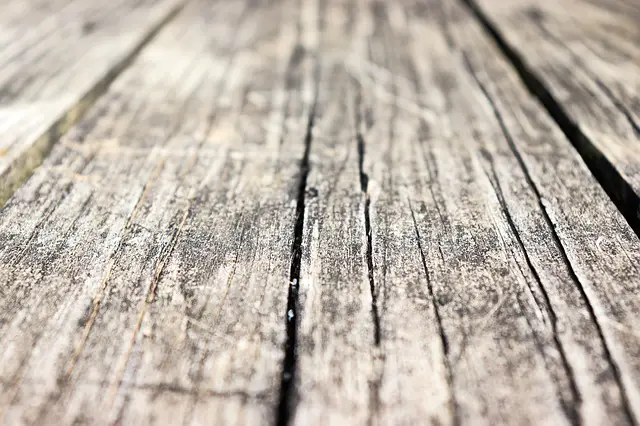Wondering how to remove mold from rough cut wood? Then you’ve come to the right place!
Rough cut, or untreated, wood is highly absorbent. It can absorb water and retain it for long periods of time.
This can lead to the growth of mold and mildew which can produce an unhealthy air quality that leads to respiratory issues, allergies and asthma.
Fortunately, mold and mildew can be removed from the wood.
This article will review the steps you need to take to keep your wood safe and clean. Let’s get started.
Contents
How to Remove Mold From Rough Cut Wood
Here are the steps you will need to take to remove mold from rough cut wood.

Use Protective Gear
When you are dealing with mold, you will want to protect yourself from any spores that may get on your skin or dislodge and become airborne.
Before beginning cleaning, make sure you are dressed in clothing that covers you from head to toe, including durable gloves.
Also wear a protective face mask to keep mold spores from getting into your lungs.
If you are using bleach, wear clothing that you don’t mind getting stained.
Remove Particles With A Vacuum
Once you are dressed in protective clothing, the first thing to do when removing mold is to vacuum the wood where the mold is growing, and the surrounding area.
This will absorb any dust and debris and eliminate any loose mold spores.
Once you are done vacuuming, empty the dust from the vacuum into a plastic bag and seal it tightly.
Apply Soap and Water or Bleach
Next, it’s time to scrub the mold to remove it fully.
If the mold has not absorbed deeply into the area, washing it with a soap and warm water solution should do the trick.
If the mold has deeply penetrated the wood, you will need to use a stronger solvent like a diluted bleach solution to remove it.
For best results, mix 10 parts bleach with 20 parts water and apply it to the surface.
Things To Note
Clean your wood outdoors if possible, so that there is good ventilation for fumes from the bleach, and to allow any stray mold spores to fly away easily.
Also allow the wood to thoroughly dry after cleaning, otherwise the mold is likely to grow back.
To do this, you can leave it outdoors in the sun, or use a hair dryer to ensure all moisture has been removed.
A hair dryer is particularly useful for drying small cracks and crevices, or if the wood cannot be moved outdoors.
How Do You Prevent Mold from Growing on Rough Cut Wood?
It’s fortunate that there are ways to remove mold from rough cut wood, but it’s even better if you can prevent it from growing in the first place.
That way, you don’t have to worry about the risk of respiratory issues, and you don’t have to go through the effort of cleaning it up.
The best way to keep mold from growing on wood is to treat it.
This involves adding a coat of sealant or finisher.
This will isolate the cracks and holes in the wood from the surrounding air and moisture to keep it mold free.
Treating wood can be done in several ways. Here is a basic rundown of the necessary steps:
- Clean the surface of the wood and giving it a light sanding
- Apply the sealer to the surface with a brush, cloth or spray gun
- Allow it to dry completely
- Re-sand and reapply sealant if required
There are several types of sealants that can be applied to protect wood from mold. These include:
- Wood sealers
- Oil finishes
- Stain sealer combos
- Varnishes
- Pressure treatments
Not only will these seal up the wood to prevent the growth of mold, but they will also give your wood a nice texture and bring out the grain.
Some will even add color. They also vary in the extent to which they absorb into the wood.
Pressure treatments can also impregnate the wood with preservatives to keep it mold free.
How to Clean Mold Off the Outside of a Home

If your home is made of wood, it may start to grow mold and mildew.
If this occurs, the process to remove it will be slightly different from the one listed above.
Bleach
Bleach is a recommended go to. However, instead of using a chlorine bleach, you’ll want to use an oxygen bleach that is less likely to cause paint discoloration and pose a threat to nearby plants.
Mix the bleach with water to get rid of exterior mold.
Always ensure the bleach is compatible with the exterior of your home to ensure no paint damage or other corrosion before using it.
Detergent and Water
While bleach is a reliable solution, it may not always be necessary.
A detergent and water solution may also do the trick, if there is only a small amount of mold or the mold hasn’t penetrated too far into the wood.
Use a strong detergent like trisodium phosphate for strong cleaning power.
Abrasive Power
To ensure the mold is removed, you need to scrub it off. One way to ensure it comes off it to use a power washer set to 2,000 psi.
A 45-degree nozzle will be best as it is less likely to cause damage to the home’s exterior.
Spray the solution on the mold. Let it sit for five minutes, then use the power washer to remove it.
Of course, a sponge or brush will also work, but it will require more effort and possibly a ladder if the mold is high out of reach.
Cracks and Textures
If there are shingles or vinyl siding near the affected area, avoid using a power washer as it can get underneath the siding and cause damage.
Use a scrub brush to get rid of the mold and rinse it with a garden hose instead.
Mold is also likely to grow in areas where two pieces of wood join such as corners on roof overhangs and between decking boards.
If you find mold in these areas, scrub them with a small wire brush or a tool brush.
Other Tips
It is recommended to do your mold clean up on a clear, dry day.
That way, the moldy areas will dry quickly preventing more from forming in the future.
How To Remove Mold From Rough Cut Wood – Conclusion
Mold is a common problem on wood – I hope this article has helped you find quick and easy ways to remove it.
Here are some related articles you may also enjoy:
Spar Urethane vs Polyurethane
Best Varnishes for Wood

About The Author: Hi There! I’m Dave. I’m a certified millworker and carpenter, and have been working in the industry for over 10 years. I created this website to pass on my knowledge so that other enthusiasts, no matter what their skill level, can enjoy the craft as much as I do. I hope you enjoy!
